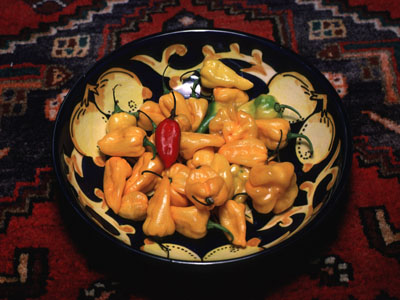The World's Hottest Pepper?
When asked, "Which is the hottest pepper in the world?", most people would respond, "Scotch Bonnet". A hotter cousin of the ubiquitous Habanero, Scotch Bonnets are indeed peppers of justifiable repute, and are at the basis of nearly all decent hot pepper sauces. But if, like the author, you spend any amount of time in St Lucia, and enjoy visiting Castries Market and talking to the Lucians about their food, you will soon discover that they have a secret weapon; a true Pepper of Mass Destruction... Stand back in awe of Mother of All Peppers, the Creole Queen: Her Majesty, Piment Ma Jacques!
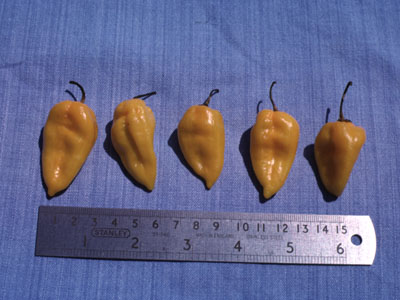
The Piment Ma Jacques
Very few people outside of St Lucia have ever heard of, let alone seen or eaten Piment Ma Jacques. Its very name seems to conjure a mixture of disbelief and amazement when, in one's best attempt at Kweyol (St Lucia's local Creole language, or Patois), one says:
Mwen vlé achté piman manjak, souplé
Or, "I want to buy Piment Ma Jacques, please". Invariably a friendly interrogation follows: "How do you know about Ma Jacques?", "Bo tjou mwen! Sir, these are really HOT!", "How can you eat such things?", and numerous variations. One definitely gets the impression that these are not your bog-standard, average common or garden hot pepper. These are peppers that deserve respect.
Often, Ma Jacques are nowhere to be found, even in the Castries Market: it would appear that they are rather seasonal, and seem to be more prevalent in the Summer months. If one is lucky enough to find them, these peppers are usually bright yellow in colour, some 4cm (1.5 inches) in length, somewhat knobbly like a Scotch Bonnet, but rather thinner and more pointed in shape.
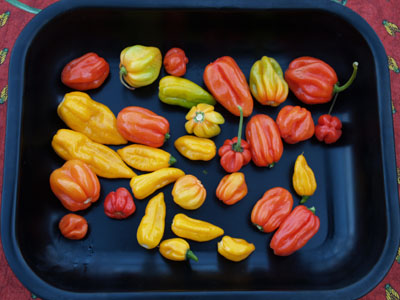
Like its Scotch Bonnet relative, Piment Ma Jaqcues is a variety of Capsicum chinense, and not the more usual Capsicum annuum that accounts for bell peppers, paprikas and the true chillis. Its form suggests that the Ma Jacques is an altogether wilder, less cultivated pepper than the Scotch Bonnet, and it is certainly all the more feisty and fiery for this apparent lack of breeding.
The Magic of Ma Jacques
When asked, "What does it taste like?", there is no easy answer as far as Piment Ma Jacques is concerned. The expected response, "HOT!!!", simply doesn't begin explain the magic of Ma Jacques. In fact, "MAGIC" would be a far better descriptions: these peppers have an overwhelmingly rich fragrance, almost a stench, overflowing with a heady mix of aromatic tropical fruits, musty straw and steamy jungle heat.
True chileheads will find the experience of eating one of these peppers raw is utterly delicious: initially, a rich sweetness fills the mouth; this is followed a few second later by a swathe of warmth that envelops every cavity in the head. Then BANG! Ma Jacques releases her massive payload of Capsaicin, and you realise you are either about to relish a serious endorphin hit, or to endure half and hour of agonising pain and frantic gasping, depending upon your tolerance to such things.
In cooking, Piment Ma Jacques is simply astounding. One small pepper, chopped and fried lightly in olive oil, alongside garlic and onions, will add enough heat and spice to a stew or casserole for four people, to make it edible only by those who are thoroughly seasoned in eating the spiciest of Caribbean or Asian food. The entire kitchen will fill with that unique perfume that can only mean Ma Jacques. Just remember not to touch your face or eyes with your fingers after preparing Ma Jacques: this is one pepper that can really hurt if put in the wrong place!
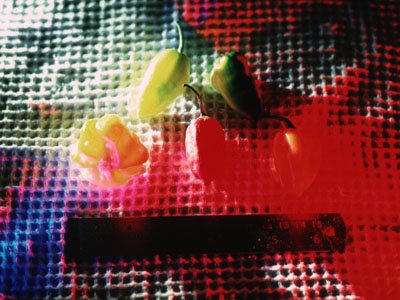
Growing Piment Ma Jacques
Because Piment Ma Jacques is grown only for local consumption in St Lucia, it is impossible to find elsewhere, especially in England, where the author lives. Luckily, the plant is very fertile, and surprising easy to grow. Equally fortunately, it also stays "true to type": if you get your seeds from a good, hot Ma Jacques, you will grow good, hot Ma Jacques.
Seeds are rescued from fresh, ripe Ma Jacques, and gently dried in the air for a couple of days, after which they can be stored for several years in simple envelopes made by folding a sheet of ordinary A4 or Letter sized paper. Even the seeds retain the pungency of their parent peppers, so much so that your entire seed cache smells "hot", even after the passage of time.
In Southern England, the best time to plant Piment Ma Jacques is in late March or early April, indoors (a greenhouse is best, but the kitchen windowsill will do). Seedlings normally take 3-4 weeks to appear, sometimes a little longer, and should be protected from frost.
When the plants have opened their first few leaves, and are some 7-10cm (3-4 inches) tall, they should be carefully transplanted into a rich, loam-based compost in individual 15cm (6 inch) pots. If space permits, these can be kept in the greenhouse throughout the summer; alternatively, they can be moved to a sunny spot in the garden from late May until mid Septemeber, after which they should be brought back indoors.
Ma Jacques like a fair bit of water, but don't inundate the plants: it's best to let them dry out to the point where the leaves are just beginning to wilt, and then to give them a good dowsing. Think of the weather where they live normally: scorching sunshine, sometimes for days at a time, followed by short, sharp showers that can dump 2.5cm (1 inch) of rain in an hour or less.
During July, the Ma Jacques will begin to flower, and pretty soon, little green, pointy peppers will begin to form. Unlike many chillis, Ma Jacques fruit hangs downwards from the peduncles (flower stalks), hidden amongst the lush foliage. By October, some of the peppers will have grown to their full size, and will begin to turn bright yellow. Once fully ripe, the peppers can be picked, or left on the plant for several weeks without suffering unduly.
From November onwards, some heating is necessary on the coldest nights, to prevent the greenhouse temperature dropping below freezing: for the sake of a little care (and fuel!), it is possible to keep cropping your Ma Jacques right up to Christmas and beyond.
Preserving Ma Jacques
Like any fruit, there are many ways of preserving Ma Jacques. The problem is that most of them involve some form of pickling, with a consequent loss of the very essence that makes Piment Ma Jacques such a uniquely wonderful pepper. Rather than "preserve" them as such, the trick is to find things to use them for which, in themselves, have a long shelf life.

One of the easiest, and most enjoyable uses for Piment Ma Jacques is to make the ultimate Hot Oil, which will last for many months and can be used to drizzle over avocados, salads, pizzas, or as an ingredient in general cooking, when fresh Ma Jacques are no longer available.
Start by selecting about two dozen ripe Ma Jacques. Chop them up coarsely, and save the seeds from the best peppers for the following year's planting. You can add some Scotch Bonnets if desired: these have a drier, less fruity flavour, and work well in the mixture.
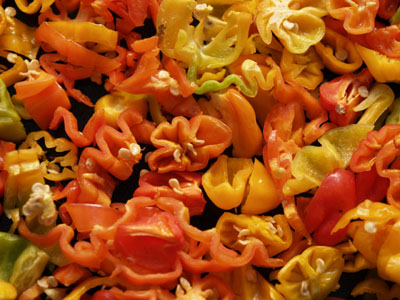
Arrange the mixed chopped peppers on a clean baking tray, and place in a warm (60 C or 140 F) oven for about two hours, to remove some moisture. It is important not to "cook" the peppers, nor to dry them out completely. If the baking tray is too hot to hold in your bare hand, then it's too hot for the Ma Jacques. Enjoy the wonderful sensation as your entire kitchen fills with that magical tropical aroma, redolent with the balmy scents of Caribbean rain forests and Creole cooking: this is what you are about to preserve in bottles to enjoy during those dark, cold winter months!
Once the peppers have dried out slightly, and have become soft to the touch, remove them from the oven, and divide them evenly into two piles, ready to feed into two clean, empty, standard 75cl (wine bottle sized) wine bottles. While they are still warm, push the peppers into the bottles, using a chopstick or spoon handle to force them down the bottles' necks. Once all the peppers are safely in place, fill the bottles with a good quality, Extra Virgin Olive Oil, leaving no more than about 2.5cm (1 inch) of air in their necks. Gently push a pair of old wine corks into the bottles, only some 5mm (0.2 inches) or so, just enough to keep out the air, dust and insects, and then wrap the bottles in Aluminium foil to keep the light out. Place them in a cool, dark cupboard and leave them for 6-8 weeks.
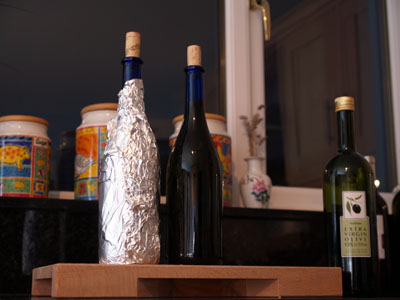
During maturation, the residual moisture in the peppers will allow some light fermentation; this can lead to a build up of gas, which in turn can "blow" the corks: this is why you should push them into the bottles no further than about 5mm. If you rammed them all the way home, you'd most likely hear a loud pop in the middle of the night, and find your cupboard and its contents festooned with delicious oil and pepper pieces, alongside a half-empty bottle. By pushing the corks in gently, all that will happen is that the cork may ease out enough to let the gas escape, but will most likely remain sitting on the top of the bottle.
While the peppers are fermenting, the oil will go cloudy. You won't see this, as you've wrapped foil around the bottles. But once fermentation is over, and the corks stop trying to escape, the oil will become clear, and will have assumed a luscious warmth that can only be engendered by Piment Ma Jacques.
Made from your first pepper harvest of the year, in early November, your "Pimjo" (Piment Ma Jacques Oil) will be ready to enjoy by Christmas. Meanwhile, keep picking the peppers, and use as many as you can fresh. They are wonderful chopped in omelettes, blended into bread dough, or mixed with potted shrimps or home-made cranberry sauce. Leave a bowlful on the table, and offer them to your guests, though be kind: warn your friends that that they are handling the World's Hottest Pepper, and that you will not be liable for any injuries causes by their misuse!
